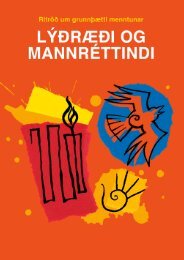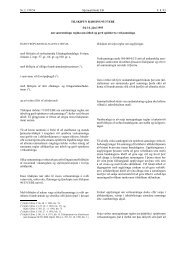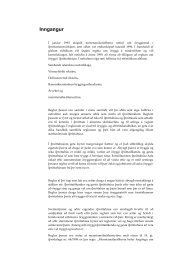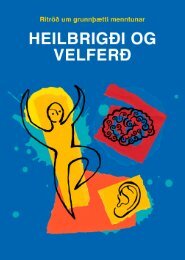Arts and Cultural Education in Iceland : Professor Anne Bamford
Arts and Cultural Education in Iceland : Professor Anne Bamford
Arts and Cultural Education in Iceland : Professor Anne Bamford
Create successful ePaper yourself
Turn your PDF publications into a flip-book with our unique Google optimized e-Paper software.
Icel<strong>and</strong> was ranked first <strong>in</strong> the United Nations’ Human Development Index report <strong>in</strong><br />
2007/2008. Icel<strong>and</strong>ers are the second longest-liv<strong>in</strong>g nation with a life expectancy at birth of 81.8<br />
years. Concurrently, Icel<strong>and</strong> is a very technologically advanced society. By 1999, 82.3% of<br />
Icel<strong>and</strong>ers had access to a computer. Icel<strong>and</strong> also had 1,007 mobile phone subscriptions per<br />
1,000 people <strong>in</strong> 2006 – the 16th highest rate <strong>in</strong> the world.<br />
Despite the current economic crisis, Icel<strong>and</strong> has a strong economic base <strong>and</strong> while the<br />
economic growth rate has slowed, it is still 0.3% per annum. Icel<strong>and</strong> is the fourth most<br />
productive country <strong>in</strong> the world by nom<strong>in</strong>al gross domestic product per capita (54,858 USD), <strong>and</strong><br />
the fifth most productive by GDP at purchas<strong>in</strong>g power parity (40,112 USD).<br />
In the beg<strong>in</strong>n<strong>in</strong>g of the 20th Century, Icel<strong>and</strong> was granted autonomous status from Denmark<br />
(<strong>in</strong> 1918), which meant that the country was free to conduct its own domestic policies. There are<br />
seventy-n<strong>in</strong>e municipalities <strong>in</strong> Icel<strong>and</strong> which govern local matters like schools, transportation<br />
<strong>and</strong> zon<strong>in</strong>g. Reykjavík is by far the most populous municipality, be<strong>in</strong>g around four times more<br />
populous than Kópavogur, the second most populous.<br />
Of particular relevance to this research, Icel<strong>and</strong> has the highest proportion of under 24 years<br />
olds of any country <strong>in</strong> Europe (36.4%) 6 <strong>and</strong> Icel<strong>and</strong> has the highest percentage <strong>in</strong> Europe of 'arts<br />
<strong>and</strong> cultural active' citizens with just under 86% activity rate reported <strong>in</strong> 2006 7 .<br />
In autumn 2008 there were 43,511 pupils <strong>in</strong> compulsory education <strong>in</strong> Icel<strong>and</strong>. The number of<br />
pupils has decreased by 330 s<strong>in</strong>ce the previous school year, or by 0.7%. It is expected that the<br />
number of pupils <strong>in</strong> compulsory education will cont<strong>in</strong>ue to decrease <strong>in</strong> the next years, s<strong>in</strong>ce the<br />
age groups that will be enter<strong>in</strong>g compulsory education are smaller than the age groups that will<br />
be complet<strong>in</strong>g compulsory education. The number of pupils <strong>in</strong> compulsory education <strong>in</strong> Icel<strong>and</strong><br />
was greatest <strong>in</strong> autumn 2003 when there was a total of 44,809 8 pupils.<br />
There are currently 173 compulsory schools operat<strong>in</strong>g <strong>in</strong> Icel<strong>and</strong> – the same number as <strong>in</strong><br />
the previous year. New schools opened while others were shut down or united with other<br />
schools. There are four special education schools operat<strong>in</strong>g <strong>in</strong> Icel<strong>and</strong> with 146 pupils <strong>in</strong><br />
attendance.<br />
The number of pupils <strong>in</strong> private schools has risen steadily s<strong>in</strong>ce 2005 (see Figure 1.4.1) but<br />
still represents a very small percentage of pupils, with the vast majority of pupils attend<strong>in</strong>g their<br />
local, government school. Dur<strong>in</strong>g the school year 2007-2008 there were 9 private schools<br />
operat<strong>in</strong>g, cater<strong>in</strong>g for a total of 664 pupils. The number of pupils has <strong>in</strong>creased by 92 s<strong>in</strong>ce the<br />
previous school year. The number of pupils <strong>in</strong> private compulsory schools has never been<br />
greater s<strong>in</strong>ce the start of the data collection by Statistics Icel<strong>and</strong> <strong>in</strong> 1997. In 2007, 54.4% more<br />
pupils attended private schools than <strong>in</strong> the autumn of 2004.Two new private schools operat<strong>in</strong>g<br />
accord<strong>in</strong>g to the Hjalli pedagogy opened <strong>in</strong> autumn 2007, <strong>in</strong>creas<strong>in</strong>g the number of private<br />
schools by a further two.<br />
Figure 1.4.1 Pupils <strong>in</strong> private schools<br />
4 http://www.statice.is/enrolled http://www.statice.is/Statistics/<strong>Education</strong><br />
5 http://www.statice.is/Statistics/<strong>Education</strong>/Pre-primary-<strong>in</strong>stitutions<br />
6 Eurostat cultural Statistics 2007<br />
7 ibid<br />
8 These figures are derived from the Statistics Icel<strong>and</strong> data collection from compulsory schools, which is<br />
undertaken <strong>in</strong> October every year. Statistics Icel<strong>and</strong> has collected this <strong>in</strong>formation s<strong>in</strong>ce the autumn of 1997.<br />
16



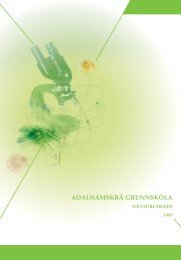
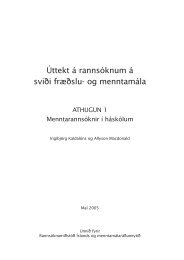

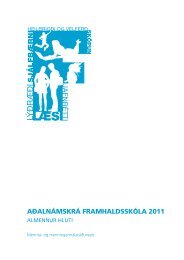
![Aðalnámskrá tónlistarskóla : rytmÃsk tónlist [Eingöngu á rafrænu formi]](https://img.yumpu.com/50843672/1/184x260/aaalnamskra-tanlistarskala-rytma-sk-tanlist-eingangu-a-rafranu-formi.jpg?quality=85)
